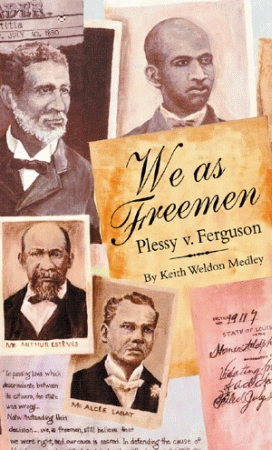‘Plessy v. Ferguson’: Who Was Plessy?
The Root
2013-06-10
Henry Louis Gates Jr., Alphonse Fletcher University Professor of History
Harvard University
100 Amazing Facts About the Negro: Learn about the man whose case led to decades of legal segregation.
Amazing Fact About the Negro No. 35: Who was the Plessy in the Plessy v. Ferguson Supreme Court case that established the separate-but-equal policy for separating the races?
‘How many mysteries have begun with the line, “A man gets on a train … “? In our man’s case, it happens to be true, and there is nothing mysterious about his plan. His name is Homer Plessy, a 30-year-old shoemaker in New Orleans, and on the afternoon of Tuesday, June 7, 1892, he executes it perfectly by walking up to the Press Street Depot, purchasing a first-class ticket on the 4:15 East Louisiana local and taking his seat on board. Nothing about Plessy stands out in the “whites only” car. Had he answered negatively, nothing might have.
Instead, as historian Keith Weldon Medley writes, when train conductor J.J. Dowling asks Plessy what all conductors have been trained to ask under Louisiana’s 2-year-old Separate Car Act—”Are you a colored man?”—Plessy answers, “Yes,” prompting Dowling to order him to the “colored car.” Plessy’s answer started off a chain of events that led the Supreme Court to read “separate but equal” into the Constitution in 1896, thus allowing racially segregated accommodations to become the law of the land.
Here’s what happens next on the train: If a few passengers fail to notice the dispute the first or second time Plessy refuses to move, no one can avoid the confrontation when the engineer abruptly halts the train so that Dowling can dart back to the depot and return with Detective Christopher Cain. When Plessy resists moving to the Jim Crow car once more, the detective has him removed, by force, and booked at the Fifth Precinct on Elysian Fields Avenue. The charge: “Viol. Sec. 2 Act 111, 1890” of the Louisiana Separate Car Act, which, after requiring “all railway companies [to] provide equal but separate accommodations for the white, and colored races” in Sec. 1, states that “any passenger insisting on going into a coach or compartment to which by race he does not belong, shall be liable to a fine of twenty-five dollars, or in lieu thereof to imprisonment for a period of not more than twenty days in the parish prison.”
It takes only 20 minutes for Homer Plessy to get bounced from his train, but another four years for him to receive a final decision from the United States Supreme Court. He is far from alone in the struggle. The 18-member citizens group to which Plessy belongs, the Comité des Citoyens of New Orleans (made up of “civil libertarians, ex-Union soldiers, Republicans, writers, a former Louisiana lieutenant governor, a French Quarter jeweler and other professionals,” according to Medley), has left little to chance.
In fact, every detail of Plessy’s arrest has been plotted in advance with input from one of the most famous white crusaders for black rights in the Jim Crow era: Civil War veteran, lawyer, Reconstruction judge and best-selling novelist Albion Winegar Tourgée, of late a columnist for the Chicago Inter-Ocean who will oversee Plessy’s case from his Mayville, N.Y., home, which Tourgée calls “Thorheim,” or “Fool’s House,” after his popular novel, A Fool’s Errand (1879). Even the East Louisiana Railroad, conductor Dowling and Detective Cain are in on the scheme.
Critically important to the legal team is Plessy’s color—that he has “seven eighths Caucasian and one eighth African blood,” as Supreme Court Justice Henry Billings Brown will write in his majority opinion, an observation that refers to the uniquely American “one drop rule” that a person with any African blood, no matter how little, is considered to be black. That Plessy’s particular “mixture of colored blood” means it is “not discernible” to the naked eye is not the only thing misunderstood about his case…
Read the entire article here.


